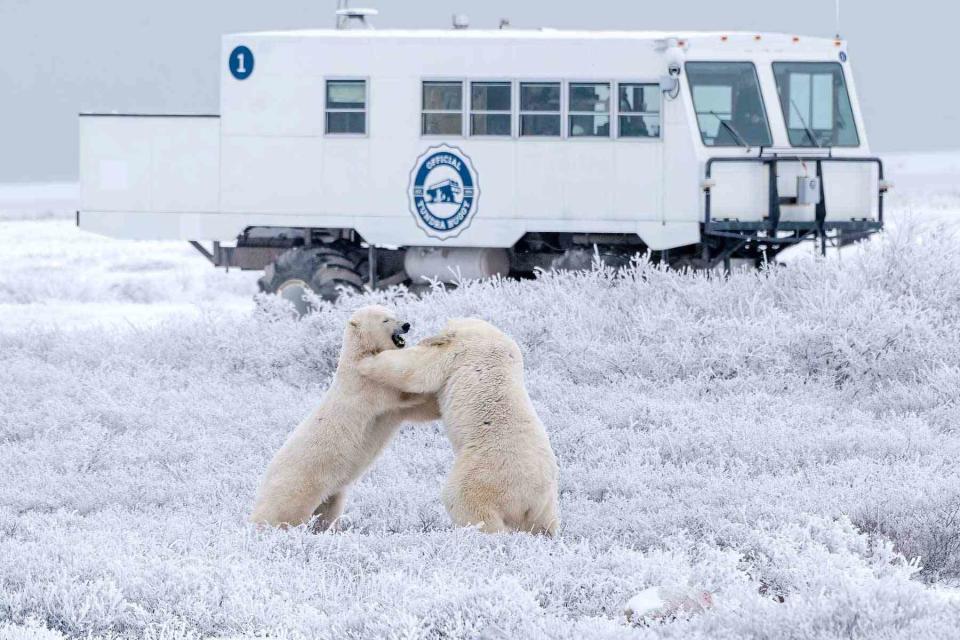I Traveled to the World's 'Polar Bear Capital' to See These Wild Animals Up Close — Here’s What I Learned
In a small Canadian town just south of the Arctic Circle, bear sightings are becoming increasingly common. One travel writer takes a tundra safari to find out why.

Jenny Wong
Bears wrestle near Frontiers North Adventures’ Tundra Buggy.It's one thing to look at a 1,200-pound polar bear from across the snowy tundra. It’s another to get close enough to see the snowflakes on its nose. In Churchill, Manitoba, both kinds of encounters are part of everyday life.
Churchill, set on the western side of Canada’s Hudson Bay, is one of the few places in the world with a human population that routinely interacts with polar bears (the town has 1,050 year-round human inhabitants, and roughly 1,200 ursine visitors that arrive during peak season in the late summer). Signs proudly proclaim it the “polar bear capital of the world.” Bears that wander into town are sometimes safely guided to “polar bear jail” — a former military aircraft hangar where they receive medical attention — and are then tagged and relocated far from town.
While bear-inflicted injuries are rare, they do happen. But there hasn’t been a fatal attack since the 1980s, thanks in part to neighborhood-watch efforts and a new radar system, known as “bear-dar,” that warns townsfolk when an animal is approaching. (Residents also typically leave their car doors unlocked, in case anyone needs to shelter quickly.)
As early as August, the bears — which use sea ice as both a means of transportation and a platform for hunting seals — begin to take refuge on land as the ice begins to recede. They will eventually come back and congregate when the ice returns in October, as they wait to catch their frozen rides out of town. That’s why each fall, some 10,000 travelers make their way to Churchill — usually on a two-hour flight from Winnipeg, as there are no roads into town — for a glimpse of the largest land predator in the world.

From left: Jenny Wong; Heather Greenwood Davis
From left: More than a thousand polar bears travel near Churchill, Manitoba, every year; Geoff York, senior director of conservation at Polar Bears International, in Churchill.I arrived in Churchill in November, which is typically just after the viewing season. There was a chance, I was told, that I wouldn’t see any bears. Still, my adrenaline ran high when, clad in cold-weather gear, I shuffled out of the Aurora Inn, where I’d spent the night. Looking left and right in case a wayward bear strolled by, I crossed the street to meet my fellow watchers. We were all on a five-day trip organized by Frontiers North Adventures, a family-owned outfitter that has been operating tours around Churchill since 1987. While bears are the big draw, visitors can also sign up to see beluga whales or the northern lights, depending on the season.
We drove out of town to meet Frontier North’s Tundra Buggy, a specialized vehicle that seats 40 and measures 13 feet from wheels to roof. Crossing the terrain, our group stared out the windows, trying our best to figure out if the large white lumps we saw in the distance were mounds of snow or fur, and looking for the telltale black noses of bears lounging in willow shrubs. Once bears were spotted, the buggy stopped. Guests were allowed to wander out to the back deck, which is suspended about five feet off the ground and has a grated floor surrounded on three sides by protective metal walls. We didn’t have to wait long — the bears aren’t shy. (In fact, we spotted about 40 of the creatures over the course of five days.) They put on a show, popping up on their hind legs and resting their front paws on the back of the buggy for a closer look, wrestling each other on the ice, striking yoga poses in the snow, or simply standing alongside the black spruce trees that, in these parts, are barren on one side from the Arctic winds. The experience was magical, but undermined by the fact that the bears weren’t supposed to be there. The season was over, but they had nowhere to go.
I spoke with Geoff York, the senior director of conservation at Polar Bears International, or PBI, a nonprofit that partners with Frontiers North. He was in a smaller buggy that PBI uses specifically for scientific research. On his laptop, he pulled up a pair of maps, one from 2015 and another from 2021, and pointed out the difference. The area was covered in ice in November 2015. Last fall there was barely a dusting of snow, much less ice. That’s a problem, because without sea ice to travel on, the bears are stuck on land and cut off from their food supply.
“Polar bears are strong swimmers, but they’re not very fast,” Dr. Thea Bechshoft, a marine mammal biologist and staff scientist with PBI, explained from her seat at the front of the research buggy. “If they’re in open water, polar bears don’t stand a chance of catching seals. They need this platform of sea ice.”

Thomas Linkel/laif/Redux
The Polar Bear Holding Facility is one of several buildings in town that have been painted with large murals as part of Project Sea Walls. This one was painted by Canadian artist Kal Barteski.On average, the bears now spend one day more on land than they did the year before, and when the bears are on land, they lose weight. That puts the world’s largest land carnivores at risk — especially for females that need to weigh more than 420 pounds to be able to reproduce. “Females are having fewer cubs on average, and the cubs are also smaller. We’ve lost about 30 percent of the bears in Western Hudson Bay since the 1980s,” Bechshoft said. For the bears that roamed outside our buggy, it had been more than 140 days since their last real meal; anything past 107 gets close to starvation, according to Bechshoft.
Bechshoft and York are two of more than a dozen researchers, scientists, and volunteers at PBI who share reports, give presentations, and run live cameras that offer people around the world a chance to see what’s happening with the bears. At PBI House — an education center in Churchill funded in part by the organization’s largest corporate sponsor, Canada Goose — there are displays, videos, maps, and models to teach travelers about the bears and their habitat.
Once you’ve seen a polar bear in the wild, it’s hard to imagine a world without them. The animals are a bellwether for other impending climate-change realities. To save them — and ourselves — we need to preserve and protect the sea ice, which has a profound influence on the global climate. “We call it the earth’s air conditioner,” Bechshoft explained, because the enormous sheet helps reflect sunlight and keep temperatures down worldwide.
On afternoons when I was not out in the buggy, I explored Churchill, snapping photos of the dozens of murals around town, painted by 18 international artists, and wandering the Itsanitaq Museum, which has a collection of Inuit carvings and artifacts, some dating back to 1700 B.C. Over evening meals at the Tundra Pub, my group gathered with the locals to swap stories, mostly about the bears — asking nervously about walks back home in the dark, or sharing recollections of the awe of seeing a mother and cub.
In the end, my only sightings came while inside the buggy, not out on the street. And once a bear was spotted, all conversation stopped. As quietly as possible, windows were lowered and cameras poised. Then, we waited, watched, caught each other’s eyes, and grinned.
A version of this story first appeared in the February 2023 issue of Travel + Leisure under the headline "Northern Exposure."
For more Travel & Leisure news, make sure to sign up for our newsletter!
Read the original article on Travel & Leisure.

